Some of my posts are heavy on words and light on photos. This one is just the opposite (despite all the introductory verbiage under the first image).
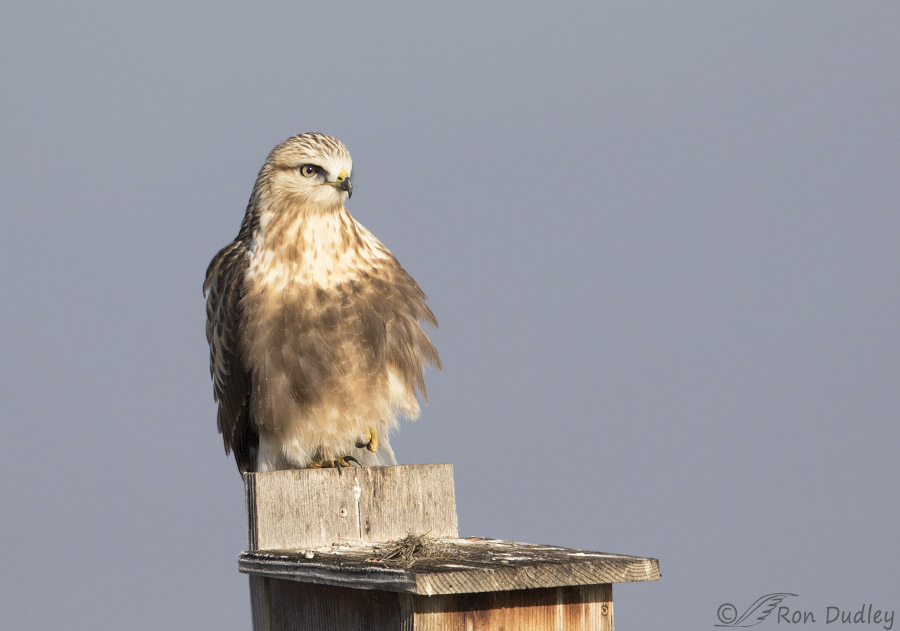
1/2500, f/6.3, ISO 500, Canon 7D Mark II, Canon EF 500mm f/4L IS II USM + EF 1.4 III Extender, not baited, set up or called in
Yesterday morning I photographed this immature Rough-legged Hawk hunting from one of the kestrel nest boxes at Farmington Bay WMA. I don’t know its sex but for the sake of convenience I’ll refer to it as a male in this post.
During some of his hunting forays from the box he would hover in the north breeze but whenever he did so he was far away and had his back to me. But for this series he had spotted an apparent vole in the grasses about 50′ below and in front of the box and I was able to photograph his reaction to the opportunity for a meal.
Soon after this photo was taken I removed my teleconverter to give me a better chance to avoid clipping wings or other body parts when (and if) he took off. As is often the case for me with series of flight shots some of the following images aren’t quite as sharp as the others but I still like all of them.
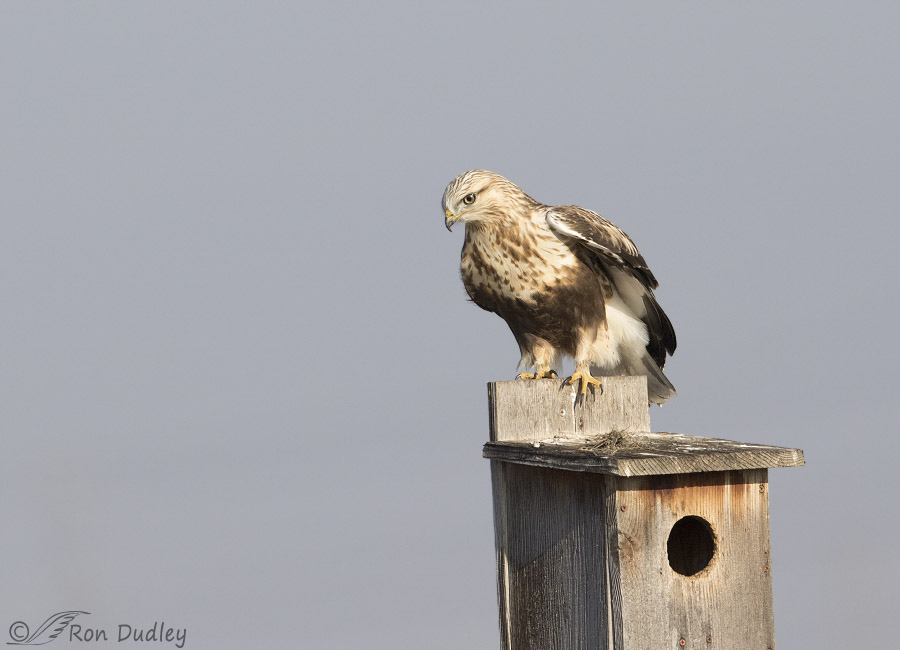
1/3200, f/6.3, ISO 500, Canon 7D Mark II, Canon EF 500mm f/4L IS II USM + EF 1.4 III Extender, not baited, set up or called in
This was the moment he spotted the vole. His attention is riveted on the potential meal and his wings are just beginning to open in the process of…
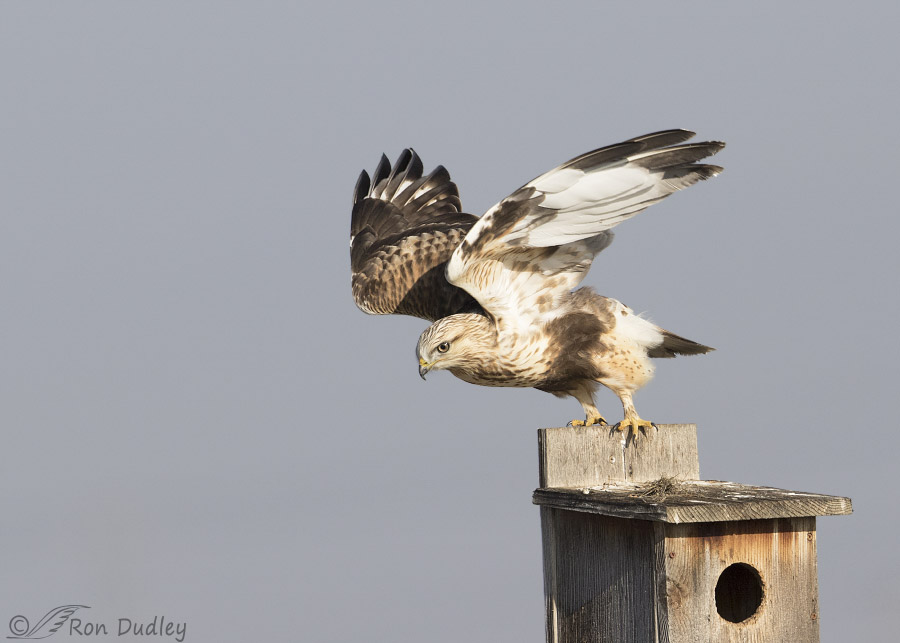
1/3200, f/6.3, ISO 500, Canon 7D Mark II, Canon EF 500mm f/4L IS II USM + EF 1.4 III Extender, not baited, set up or called in
lifting off in pursuit.
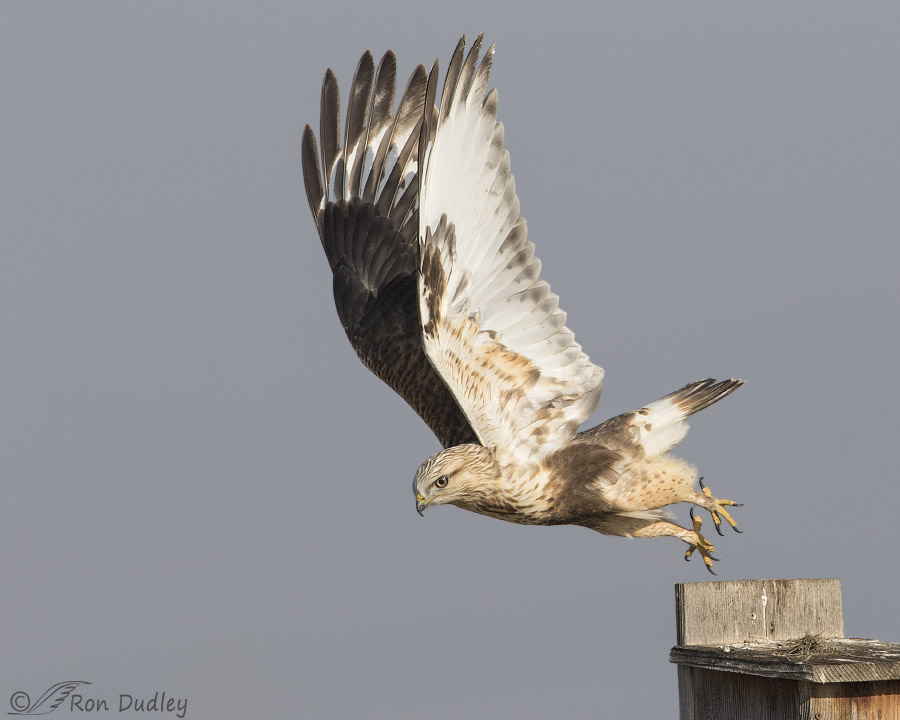
1/3200, f/6.3, ISO 500, Canon 7D Mark II, Canon EF 500mm f/4L IS II USM + EF 1.4 III Extender, not baited, set up or called in
Here the whites of the left wing are facing the sun directly so some of them are just a little bright but I really like the takeoff posture.
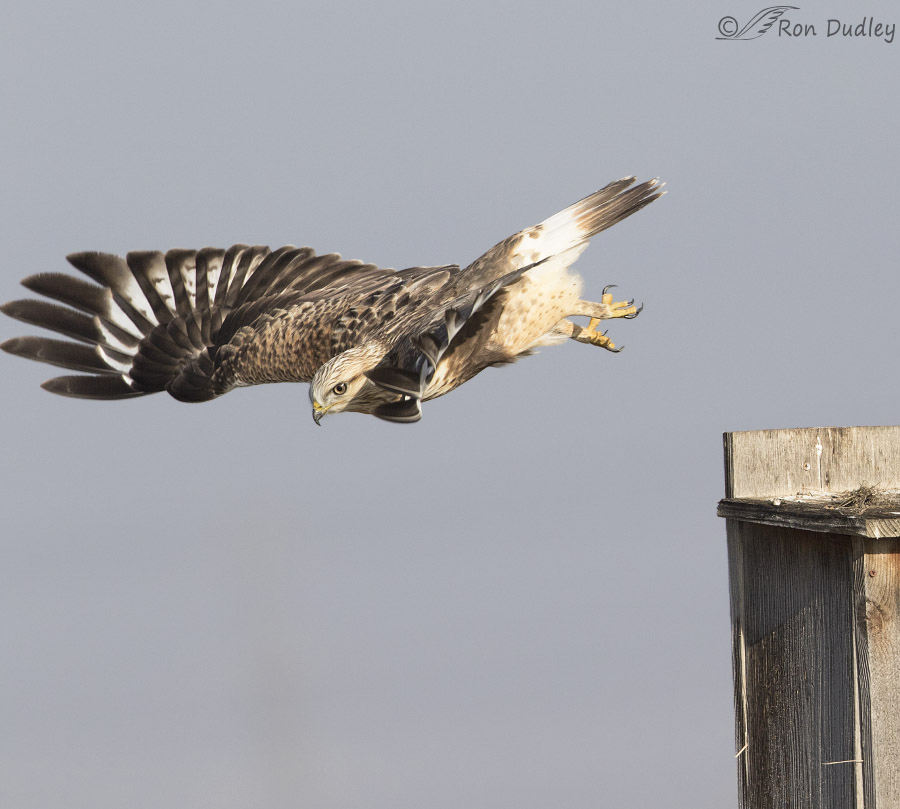
1/3200, f/6.3, ISO 500, Canon 7D Mark II, Canon EF 500mm f/4L IS II USM + EF 1.4 III Extender, not baited, set up or called in
You can imagine my reaction to barely clipping his right wing.
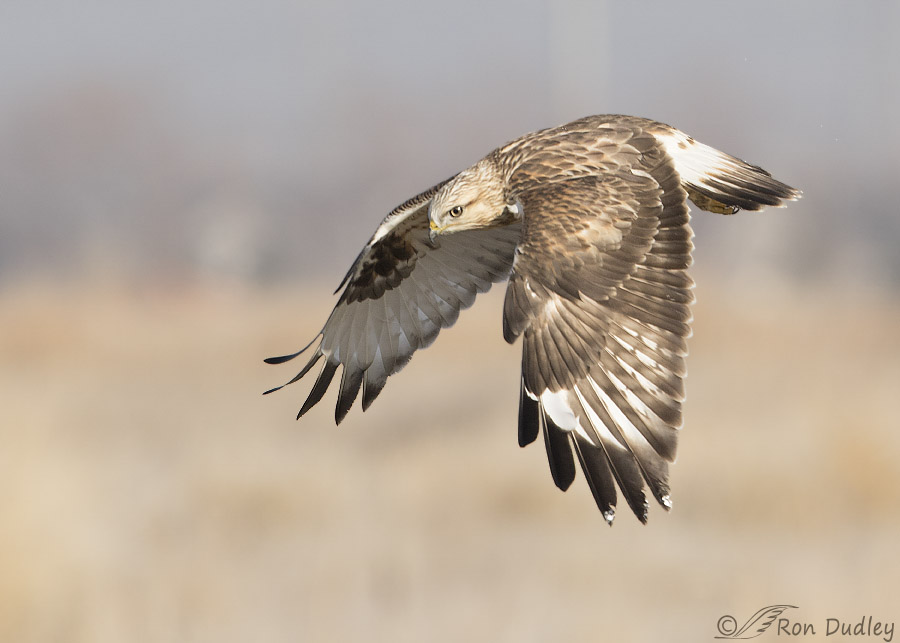
1/2000, f/6.3, ISO 500, Canon 7D Mark II, Canon EF 500mm f/4L IS II USM + EF 1.4 III Extender, not baited, set up or called in
Four frames later he had descended far enough to begin having grasses in the background (I’m not happy with the out of focus wide vertical white line above the hawk).
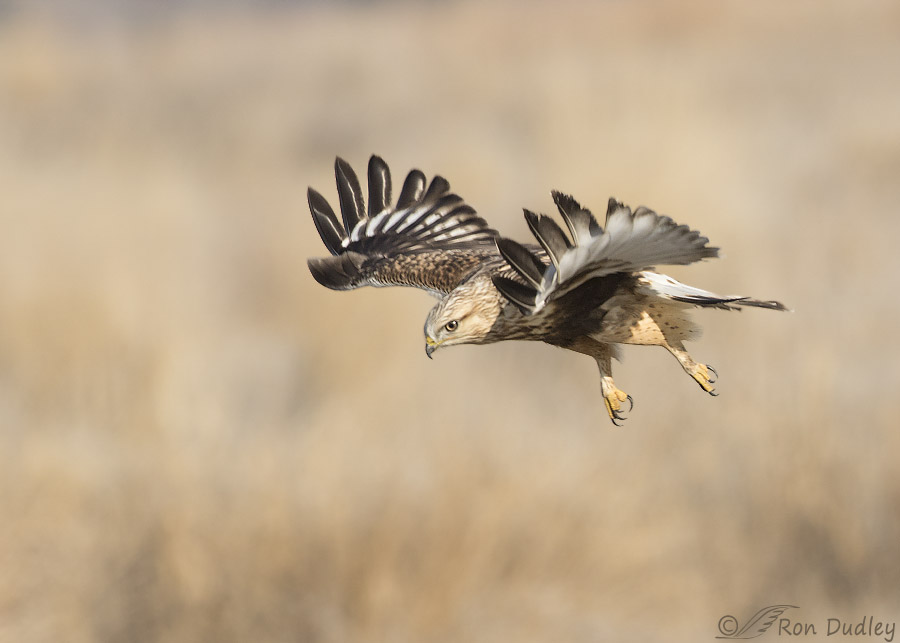
1/2500, 6.3, ISO 500, Canon 7D Mark II, Canon EF 500mm f/4L IS II USM + EF 1.4 III Extender, not baited, set up or called in
His legs are coming down in anticipation of…
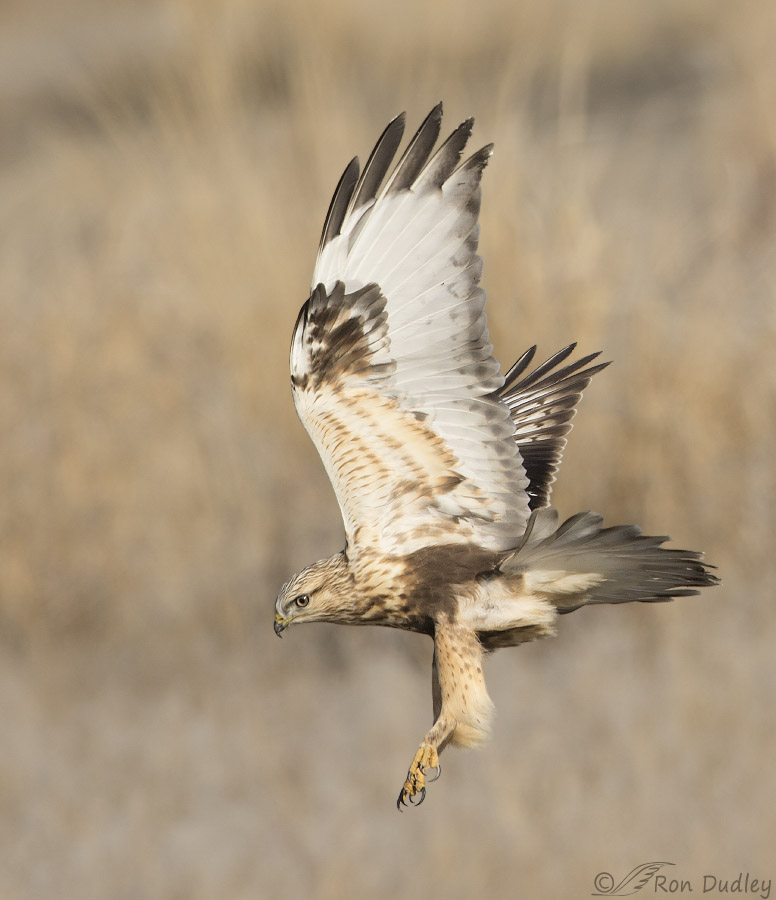
1/3200, f/6.3, ISO 500, Canon 7D Mark II, Canon EF 500mm f/4L IS II USM + EF 1.4 III Extender, not baited, set up or called in
grasping the vole in the grasses.
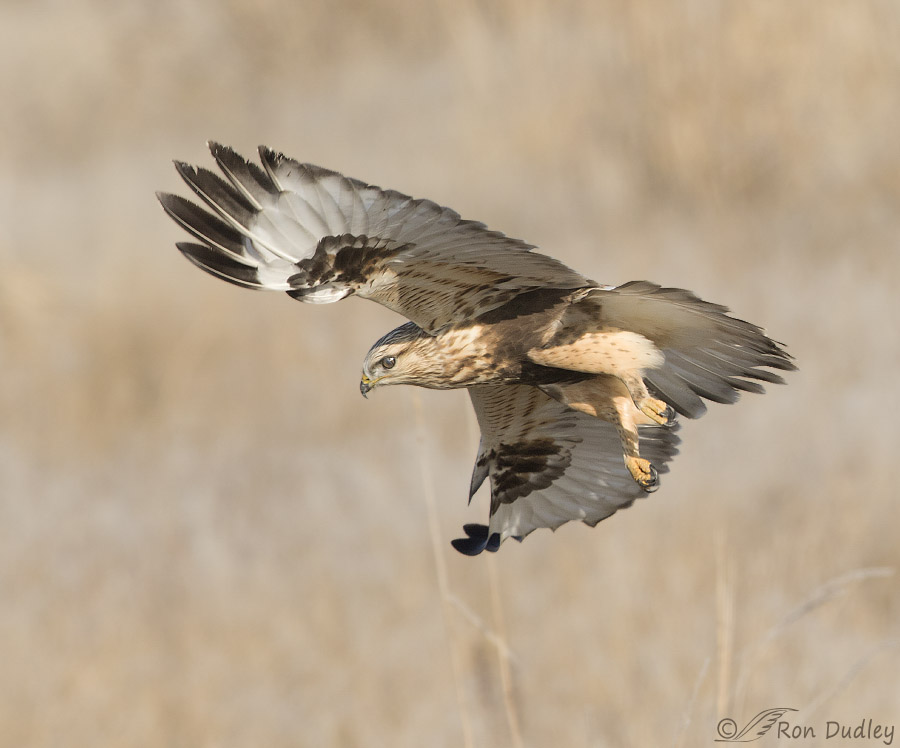
1/2500, 6.3, ISO 500, Canon 7D Mark II, Canon EF 500mm f/4L IS II USM + EF 1.4 III Extender, not baited, set up or called in
But then at the last second the vole apparently made its escape into its tunnel and/or disappeared in the vegetation so the hawk began to veer off and abandon its pursuit. In this shot the nictitating membrane is partly closed, covering the back half of his eye. I also notice that he has temporarily deployed both alulae.
At this point I figured the hawk would continue its wide curving flight away from me and either land somewhere else or hunt from the air far away but he made a serendipitous decision for me and…
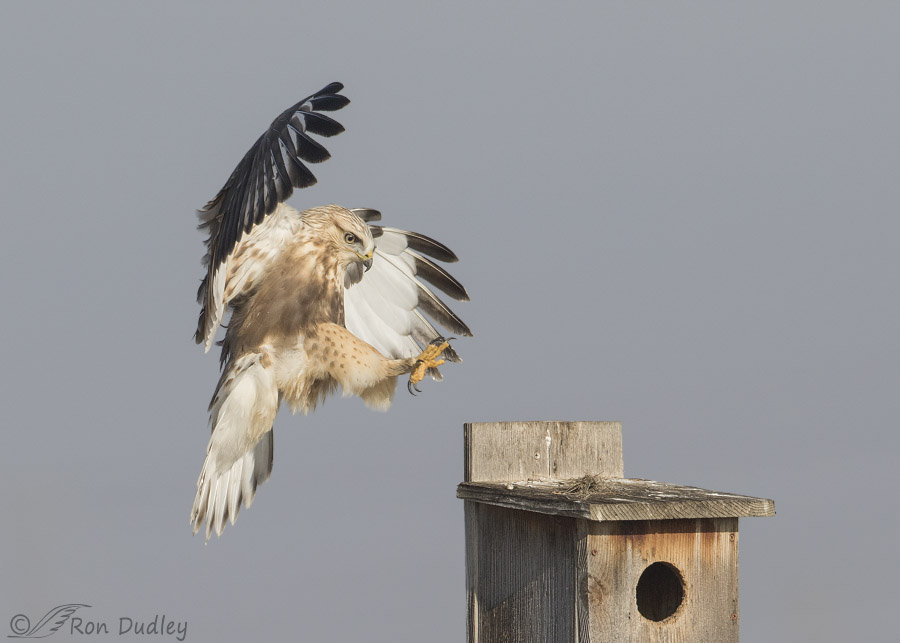
1/3200, f/6.3, ISO 500, Canon 7D Mark II, Canon EF 500mm f/4L IS II USM + EF 1.4 III Extender, not baited, set up or called in
returned to the nest box to hunt some more. As I saw him approaching I pre-focused on the box and caught him during the landing process.
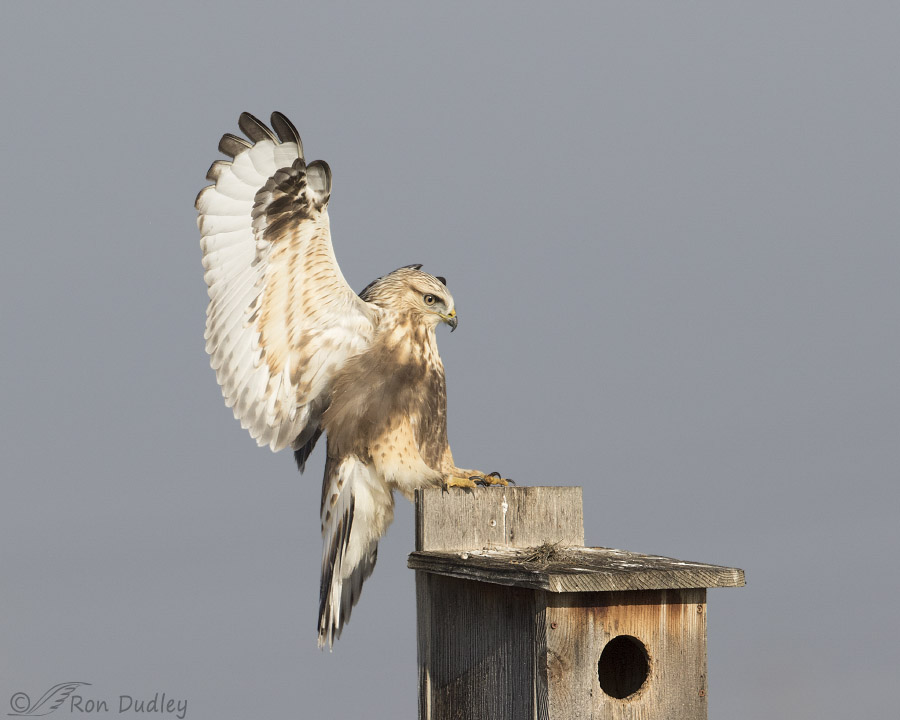
1/3200, f/6.3, ISO 500, Canon 7D Mark II, Canon EF 500mm f/4L IS II USM + EF 1.4 III Extender, not baited, set up or called in
Touch-down.
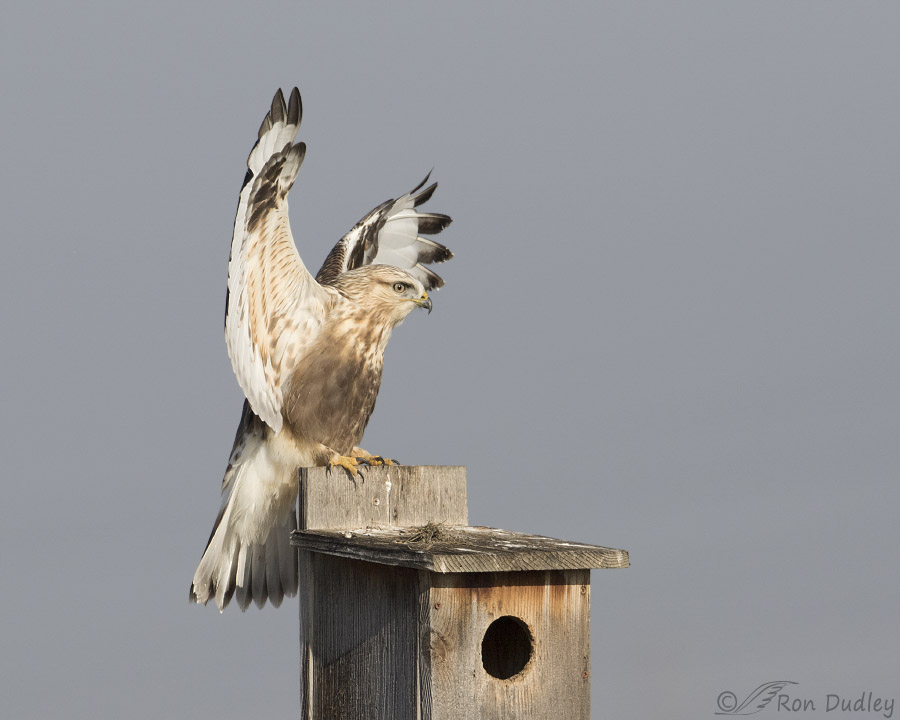
1/3200, f/6.3, ISO 500, Canon 7D Mark II, Canon EF 500mm f/4L IS II USM + EF 1.4 III Extender, not baited, set up or called in
Despite being a young and relatively inexperienced bird he nailed the landing…
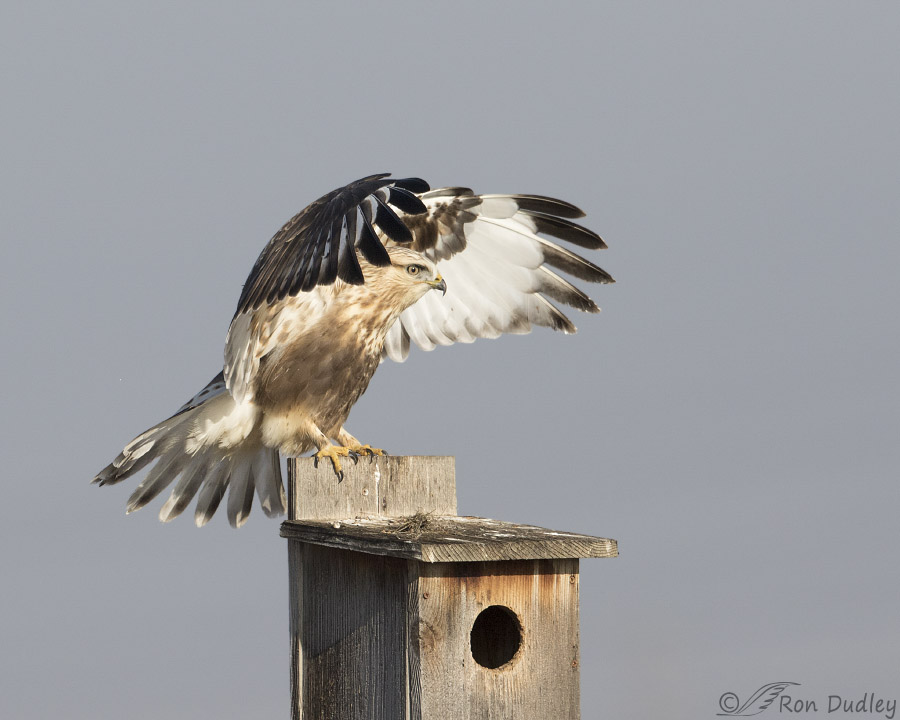
1/3200, f/6.3, ISO 500, Canon 7D Mark II, Canon EF 500mm f/4L IS II USM + EF 1.4 III Extender, not baited, set up or called in
with the help of his flared tail and arced wings.
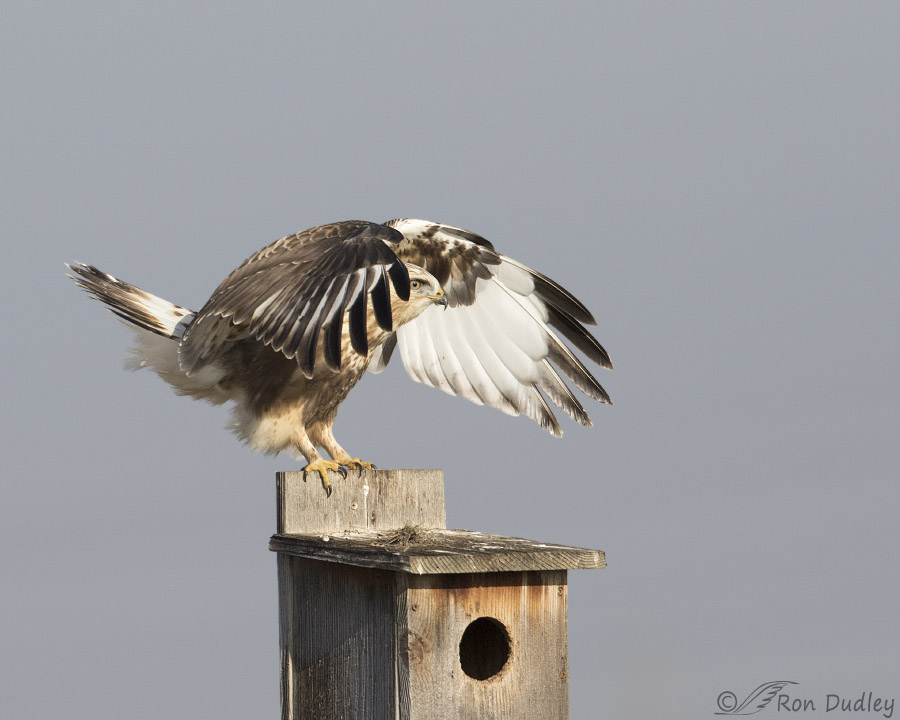
1/3200, f/6.3, ISO 500, Canon 7D Mark II, Canon EF 500mm f/4L IS II USM + EF 1.4 III Extender, not baited, set up or called in
Here the wingtip almost blocked the eye but we can still see it so the photo works for me. In fact I think that peekaboo effect might actually enhance the image.
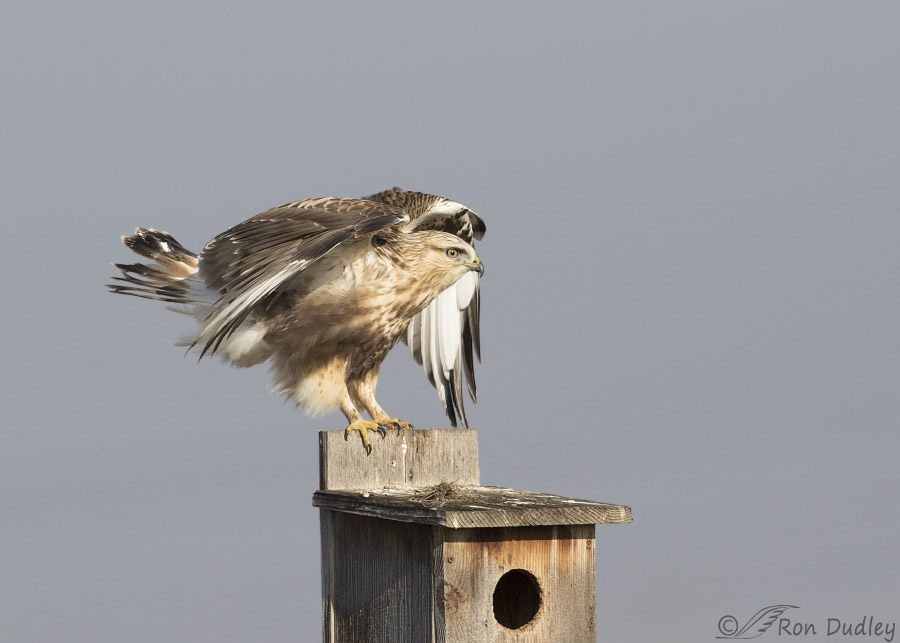
1/3200, f/6.3, ISO 500, Canon 7D Mark II, Canon EF 500mm f/4L IS II USM + EF 1.4 III Extender, not baited, set up or called in
As he began to fold his wings I thought it was interesting to see in freeze-frame how he does it.
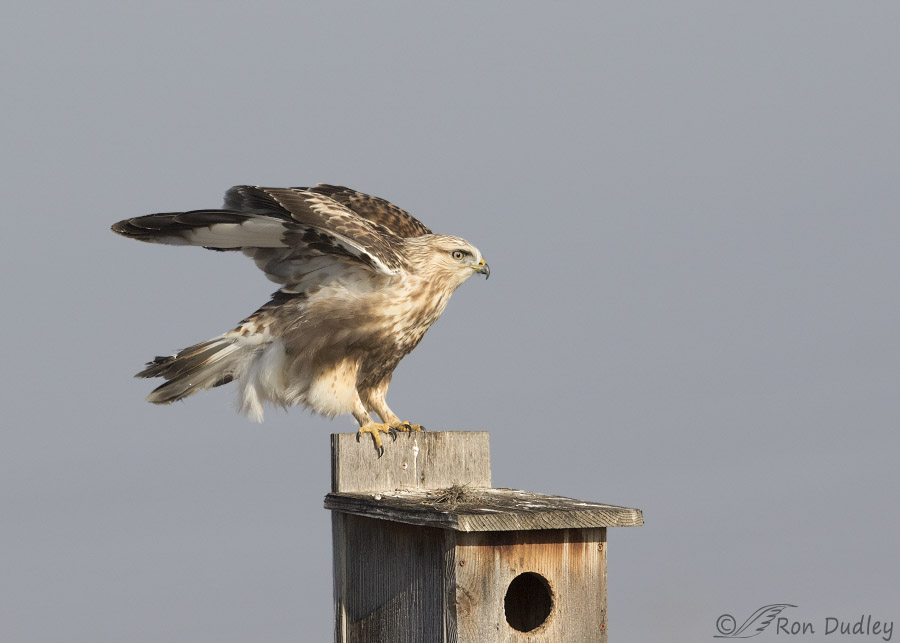
1/3200, f/6.3, ISO 500, Canon 7D Mark II, Canon EF 500mm f/4L IS II USM + EF 1.4 III Extender, not baited, set up or called in
The longer primaries are retracted and compacted first and then folded under the curved arc of the secondaries…
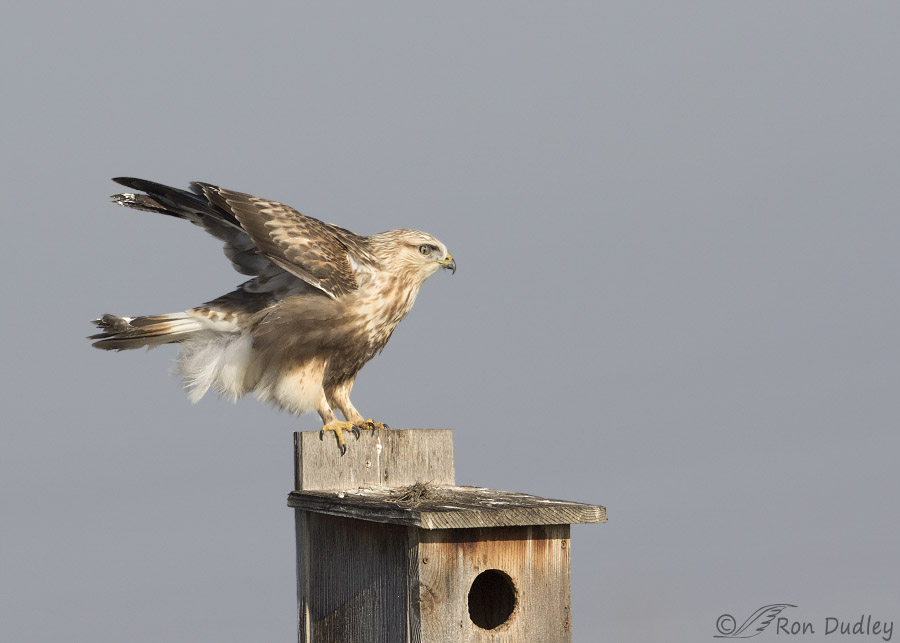
1/3200, f/6.3, ISO 500, Canon 7D Mark II, Canon EF 500mm f/4L IS II USM + EF 1.4 III Extender, not baited, set up or called in
before the bird begins to lower the entire curved and compact package onto his back.
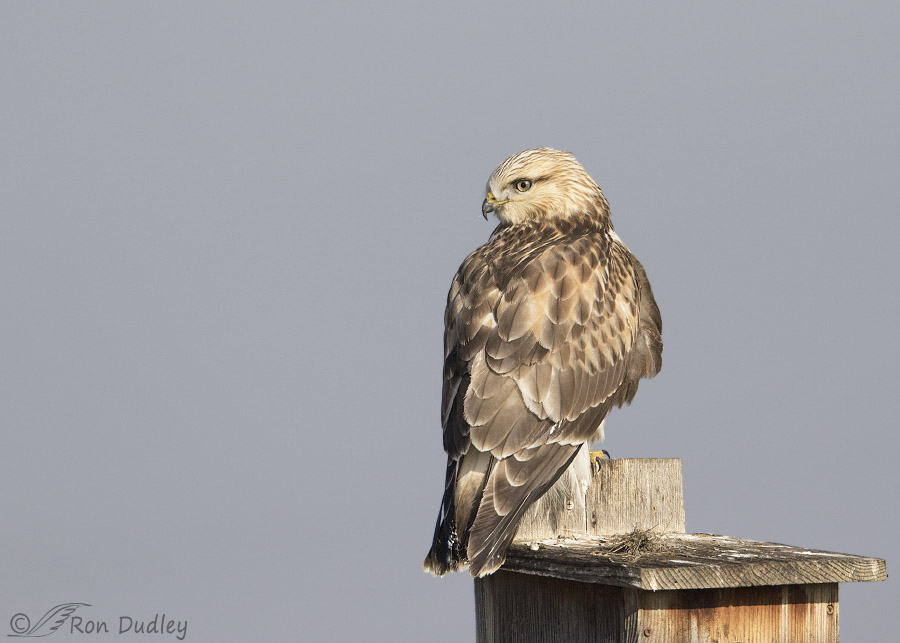
1/4000, 6.3, ISO 500, Canon 7D Mark II, Canon EF 500mm f/4L IS II USM + EF 1.4 III Extender, not baited, set up or called in
In this view we see the neat layering of primaries, secondaries and coverts ready for instant deployment in the next flight. In a later hunting trip from the box this bird successfully captured a vole and returned to the next box with it. I’ll likely post that series at another time.
Gawd, I think Roughies are beautiful raptors!
Ron
PS – Eighteen images in a single post is a new record for me. I hope so many images doesn’t bog down viewing devices but if it does I’d like to know about it for future consideration.


Just Beautiful !!!
I realized this morning another reason I so appreciate your work. A good deal of my video consumption is wildlife documentaries and your posts fit that category for me. Beautiful and very informative.
Such a fantastic series! Totally looking forward to your next “record number of shots” post! (Love the “wordy” ones too — I always learn a lot!) 😀
I hope it’s a while before I post more than 18 images, Marty. Too much damned work! 🙂
No problem loading these images at all.
And since you picked your nits, I’ve got one of my own. This little juvie needs to do some preening! Maybe it’s the falconer in me, but I just hate it when they’ve got poop in their feathers! That’s my nit.
Now, moving on to the utter spectacularness of this series!! My nit aside, I was enthralled at each and every one of these shots. There’s just something about raptors, isn’t there? OK, I’m not THAT picky–include all other birds and critters, too! But just WOW!
Glad Mia caught the results of his/her successful hunt (vole). I’m delighted s/he scored a meal! That makes me happy.
Jack scored today, too. That’s the good/great news. The bad news is he and I came out of it with about eleventy zillion cactus needles in various places including several in my boob for pity’s sake. SIGH! Jack only had one in his foot. I’ll be picking them out for days to come! Sometimes it’s rough being a human.
Ouch, Laura. I can only imagine!
Now tell me something. How in the hell did he get poop on the top of his primaries? I suspect that’s what it is, but…
Wow! What a superb series of images! The “feature image” which shows the hawk about to land made me so curious about how and where he was going to land. And yay! You posted frame by frame photos of the whole process. So cool! And big cheer for the wing almost covering the eye but not covering it (it is so great when that happens)!
I get excited about drawing so many of your photos. Do a lot of artists use your photos as references? I drew one of your magpies a while back and I’m wondering if it would be ok with you if I used another photograph of yours as a reference? I don’t sell my drawings so I would prefer no fee or a low fee. What would be your preferred fee if I were to sell a drawing (very hypothetical) based on one of your photos?
Thanks for this beautiful series. 🙂
Thank you, Myriam.
I appreciate your interest in my images but except for special cases (where I always charge a licensing fee – for me it’s a matter of principal) I generally don’t allow my images to be used as references or models for paintings. When it happens without permission and I discover it I feel like I have to pursue it legally whenever possible. I’ve become very frustrated by artists who use my images without permission and violate my copyright.
I know I let you use my magpie but I prefer that not to continue. It opens up a Pandora’s box that I’d rather not have to deal with. Right now I’m dealing with a situation where an artist used one of my hawk photos in a mural hanging in a Texas Roadhouse restaurant without permission and it isn’t fun. I hope you understand…
I am sad that I don’t meet your criteria for using your images, but I understand that you are very selective about the cases when you let your images be used as references/models. You created the images and you hold the copyrights, so I respect your decision. I will continue enjoying viewing your images as you add them to your blog. Good luck with the mural situation. I hope it doesn’t take too much time and energy before it gets worked out, hopefully in your favour. 🙂
I look forward every morning to getting daily tutorials from both you and Mia. However, this morning I had to laugh out loud because on Thursday the 14th I enjoyed photographing this very same roughie hunting from the same Kestrel box going after the same family of voles. In fact, when I pulled up my photos I knew right away that it was a juvenile because of your earlier post regarding sexing rough-legged hawks. Your blog has really made a difference in improving my ability to photograph and appreciate these beautiful raptors. The information you provide has been incredibly helpful to me. Thank you!
I loved your feedback, Dennis. I enjoy it very much when blog readers learn from my posts but often I never hear about it. So thank you.
And yes, that nest box is one of the most popular perches at Farmington for both raptors and photographers.
Oh.
As this series unfolded my favourite image changed. Multiple times. Consider me gob smacked. And flabber ghasted.
Thank you so much for the details which my eyes will never see anywhere else. The freeze frame is an amazing thing isn’t it?
Mia’s post reminded me that I had been so awed by this series that I ommitted commenting on the bonus britches. I have corrected my error now.
Thanks, EC. Yes, The fast shutter speed of modern cameras when combined with a powerful lens is a great tool for seeing details of behavior and structure that the naked eye would never notice in a wild and free bird. Amazing is right.
An absolutely fantastic series, in what is beginning to be a favorite when they visit Utah.
I enjoyed every image, lucky vole.
Yup, that vole had damned good timing, Kelly. The next one wasn’t so lucky…
Exceptional shots Ron. Although I love ALL birds of prey regardless of the Continent’s they are from, my favorite Eagle is the Golden, Falcon is the Gyr and hawk is the Rough-legged. I think besides the actual beauty of this hawk, I intrinsically like the fact that it survives in a very difficult arctic landscape during Spring to Fall and in Winter visits us for our absolute enjoyment. This is a wonderful series. Many thanks for sharing!!
Agreed, Dick. They’re a wonderful and timely temporary winter replacement for our Swainson’s Hawks. Thank you.
I once had a Nile Crocodile look at me with eyes like that. Not a relaxing experience. I don’t think most people are appreciayive enough of how comparatively easy life is at the top of the food chain where we live. Great shots. In this era of A.D.D. sound bites I appreciate you including all the shots for a full look at what you were seeing.
“I appreciate you including all the shots for a full look at what you were seeing”
Thanks, Porcupine. But in all honesty I didn’t include “all the shots” because some of them were clipped or something else went wrong. You can always tell how many I skipped by passing your cursor over the image and comparing the file numbers (if you’re using a device with a cursor).
Porcupine – I had to smile about your comment of the look of a Nile Crocodile. I understand because of probably a similar look I got from a very large South American Caiman when I got too close the waters edge. It certainly wasn’t relaxing for me and makes one appreciate the lack of fear we have from every day predators.
I had absolutely no problem loading this post, and I’m glad there are so many images. I am not personally familiar with Roughies, but I can tell from these images why people like them so much. This is one handsome and personable bird. I am fascinated by the landing process, because the birds always seem to land in a position where I would expect them to fall over backwards, but somehow they never do. It’s wonderful what wings can do for them.
“the birds always seem to land in a position where I would expect them to fall over backwards”
Exactly, Susan. That’s where their skill at using their momentum comes into play. Landing is a complicated endeavor and it always impresses me when it’s done well (and it usually is).
Lovely series, Ron! Thank you for sharing them! And yes, Roughies are gorgeous raptors!
They are indeed. Thank you, Thomas.
Spectacular series of a species I don’t encounter often enough! Thanks, Ron!
I wish you luck with more of them in the future. Thanks, Diane.
Just magnificent, from first to last–congratulations ! I actually “heard” Wagner’s “Ride of the Valkyries” in my head while looking at your glorious images………
“I actually “heard” Wagner’s “Ride of the Valkyries” in my head while looking at your glorious images”
It’s all about anticipation, isn’t it, Kris. Thank you.
Ron
what a great sequence. Glad you kept them all and shared them. Your description of his feathers was superb. No problem for me to download all. And I can keep them in my mind’s eye for a long time.
Thank you. Diana
Thanks, Diana. It’s good to know that so far at least apparently no one has had difficulty loading so many images. I was worried about that. Hopefully that won’t change with the new throttled internet in store for us…
Double D Dang, what a beautiful series of images. We don’t see Rough Legged Hawks in the Monterey Bay area.
And double T thanks for the kind words, Dan.
Nice! Coincidentally, two days ago I photographed a peregrine falcon from liftoff to flight, also in great light. I’m with you – watching the mechanics of the wings is fascinating. Not to diminish the gobsmack effect of witnessing such a creature.
Great light makes a huge positive difference, Martha. Thank you.
What a beauty of a bird. Wonderful images. Thanks Ron!
Thank you, Jean.
Those images are a great joy to see, thank you for sharing
I’m glad you like them, Carlotta.
Thanks for the wonderful series of a beautiful bird…
You’re very welcome, Patty.
Wonderful series Ron. Beautiful bird and beautifully captured. My favorite, #8. Perfect position from my perspective. Again, thanks for sharing!
#8 seems to be the consensus so far, Frank. I like that one a lot too. Thank you.
Oh wow wow wow!!! I just can’t seem to capture those types of shots mine are fuzzy and out of focus kind of why I have lost my enthusiasm .. need help not going to figure this camera out on my own .. these pictures are a tribute to your skills!!!!
Marina, I get my share of soft shots too. Yesterday morning I photographed the first Bald Eagle I’ve seen on Antelope Island (instead of the causeway to the island) in years. I was close to the bird and still most of those shots were soft. I wasn’t a happy photographer…
Awesome! Love the landing shots and your details. I probably wouldn’t have noticed the white line if you hadn’t pointed it out!And the peak-a-boo definitely enhanced the picture! Wonderful series!
Beth, that white line probably bothers me more than it should. But it’s so straight that it’s obviously an unnatural element and I’m hypersensitive to that kind of thing… 🙂
I would be on my own but not on others. All my focus is on the crisp hawk itself.
I loved this series! No problem downloading. Thanks for the Treat.
Len
Thanks for that feedback, Len.
Wow! I love this series and that bird! The sequence has captured this hawk’s athleticism and beauty. Number 8 is a killer shot, a classic! Getting to see the images preceding and following it is an education in photo technique.
By the way, I love your “wordy” posts too. They are interesting, educational and sometimes humorous. You seem to speak when you have something to say and you are very wary of pontificating.
Joanne, In #8 the bird was close enough to the left frame edge that I was lucky that his pose looked best in a vertical composition.
I really appreciate your feedback about my “words” and you were very accurate about my efforts to avoid pontificating. It turns me off when I have to read stuff like that and I’ll avoid doing so whenever possible.
WOW! What a wonderful series, Ron! 🙂 One would never “see” all the detail “live” that you captured here.:)
Judy, I don’t see that detail either when I’m watching with the naked eye or even through my viewfinder. The freeze frame details in the images are one of the many reasons I enjoy bird photography so much.